Equipping Wisconsin Farmers to Conduct On-Farm Nitrogen Research
The Nitrogen Optimization Pilot Program (NOPP) was developed to support Wisconsin farmers to address farmer-driven nitrogen management questions that can improve farm profitability and reduce nitrate leaching to ground and surface waters.
NOPP grants may provide up to $50,000 per producer per funding cycle, with up to 20% of the award directed towards UW–Madison (UW) for monitoring. The grants are designed to encourage producers to develop innovative approaches to optimize the application of commercial nitrogen. For the 2024-25 cycle, the program focused on replicated and randomized two-year nitrogen-rate trials. NOPP is funded by the state of Wisconsin, administered by the Wisconsin Department of Agriculture, Trade, and Consumer Protection (DATCP) and supported by UW.
Due to Wisconsin agriculture’s unique variety in soil types, management systems, and weather patterns, localized trials can assist farmers in optimizing commercial nitrogen fertilizer management on individual farms. Furthermore, on-farm research reaches beyond individual farms to support local resources and regional peer-to-peer learning. Data resulting from NOPP projects will also contribute to UW statewide nitrogen guidelines, furthering the impact of these projects.
Currently funded projects evaluate optimum commercial nitrogen rates for corn grain and silage, potatoes, forages, cranberries, and sunflowers, with additional topics investigating manure and legume crediting, cover crops and nitrogen cycling, new products and technologies, and the influence of inherent soil or landform properties. As the first funded NOPP projects wrap up and data is analyzed and shared back to farmers and partners, final reports will be shared publicly on the DATCP NOPP webpage.
NOPP By The Numbers
67
On-farm research trials conducted in 2024
105
On-farm research trials conducted to date
106,140
Acres covered by participating farms
Which crops’ nitrogen responses are being investigated?
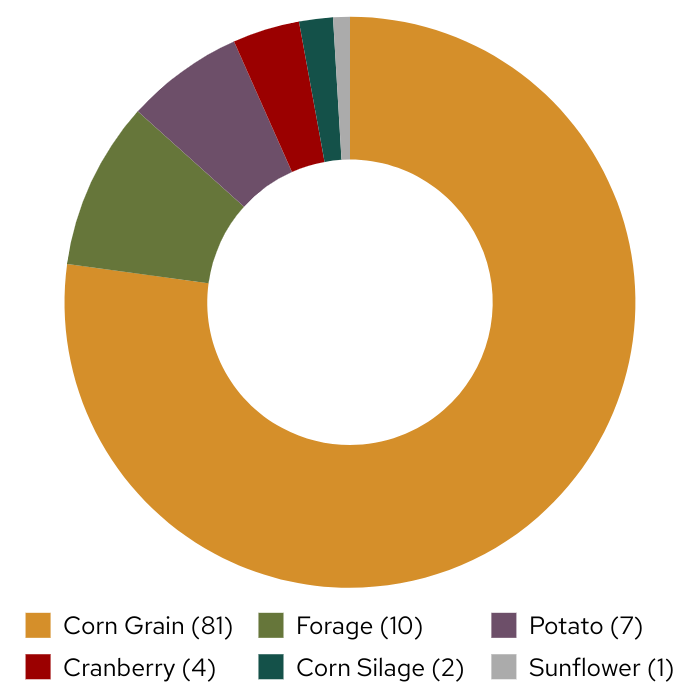
Corn grain: 81 projects
Forage: 10 projects
Potato: 7 projects
Cranberry: 4 projects
Corn silage: 2 projects
Sunflower: 1 project
2024 Outreach Efforts
2,066
Individuals engaged in NOPP and on-farm research knowledge sharing at over:
7
Conference sessions
16
Field days
19
Meetings
Program Details
All projects funded by NOPP began with a farmer-driven research question. Due to the unique farming environments across Wisconsin, NOPP was designed to let farmers take the lead. With an expansive variety of soil types, management practices, and weather patterns, Wisconsin farmers are best able to identify the specific nitrogen-related challenges on which they need more research.
Requirements surrounding eligibility and project design are outlined under Wisconsin Statute 92.14(16) and are enforced by DATCP:
- Projects must include at least two growing seasons
- Priority will be given to innovative projects not currently funded through state or federal programs
- Priority will be given to longer-term projects
- Projects will collaborate with UW for technical assistance and data analysis
- Farmer applicants are encouraged to work with any other partners such as private agronomists, county conservation staff, etc.
While DATCP is the owner of the program, UW assists grantees to:
- Design their project to work under the farmer’s specific management and answer their research question
- Analyze and interpret data
- Share the results back to the farmer and create outreach materials
Generating Reliable, Widely Usable Data on Wisconsin Farms
NOPP is managed to empower farmers to take the lead in their on-farm nitrogen research, and it all begins with their own unique research question. From there, the trial design and data collection protocols are largely driven by the characteristics of their farm and the research question to shape participants’ nitrogen management decisions on their farm.
Subsequently, this local research will support local resources and regional peer-to-peer learning. Despite the unique nature of each project, there are similarities in trial setup and data collection as dictated by the program. All projects investigate four to six nitrogen rates and four replications, routine soil samples, soil nitrate samples, and yield data. These similarities give projects scientific vigor and allow results to feed into datasets that contribute to statewide nitrogen guidelines.
Funding Breakdown
Nearly $2.6 million was awarded in 2023 and 2024, while $3.2 million was requested. A funded project may include multiple farmers, each implementing the same trial per year, for two or more years.
| Funding Year | Number of Projects | Number of Farmers | Number of Trials to Date | Trials to be Completed |
|---|---|---|---|---|
| 2024 | 18 | 27 | 27 | 52 |
| 2023 | 21 | 49 | 78 | 89 |
$ Awarded to Project Categories
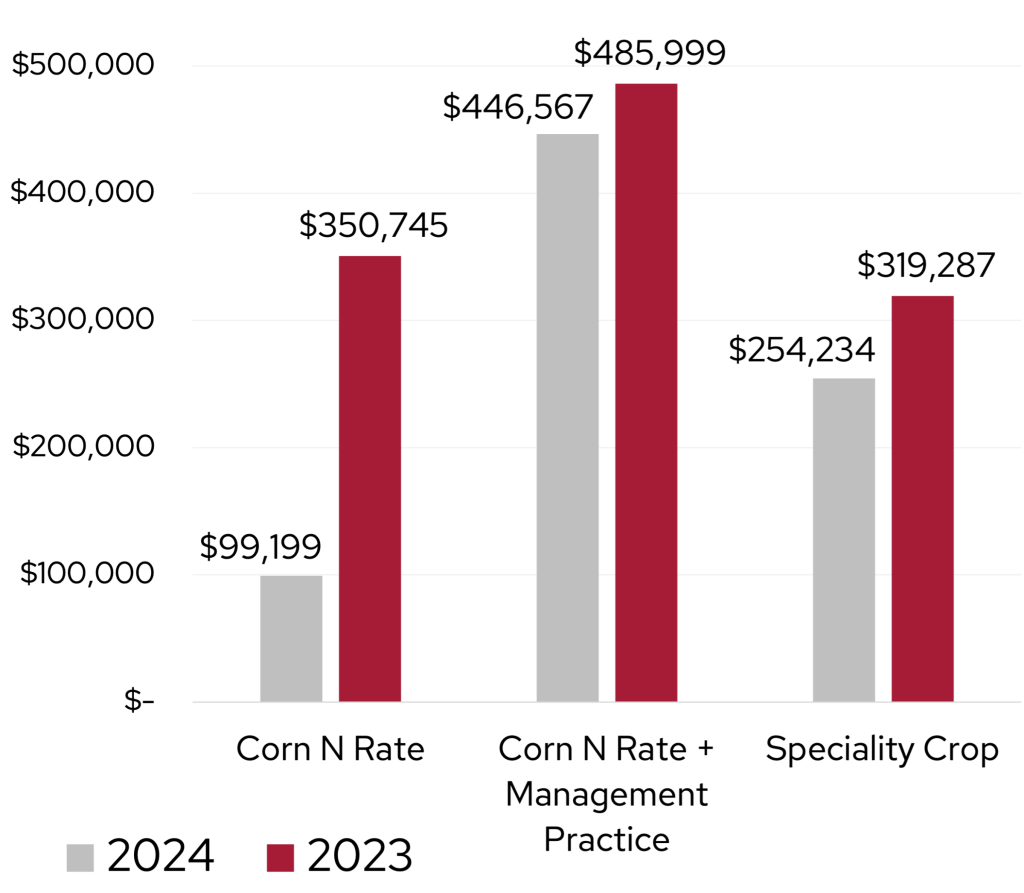
Partnering with Watersheds for Increased Impact
A goal of NOPP is for the results of each trial to extend beyond the farms directly involved in the project. The Producer-Led Watershed Protection Grant Program (PLWPG) funded by DATCP was designed to improve Wisconsin’s soil and water quality through on-farm research, education, and outreach.
Producer-led watershed groups are uniquely positioned to conduct NOPP projects that involve more than one grower within a watershed and share their experiences and findings with other farmers in the area. While many farmers participating in NOPP are also members of a producer-led watershed group, here we highlight groups that utilized the existing framework of the PLWPG to conduct on-farm nitrogen research through NOPP.
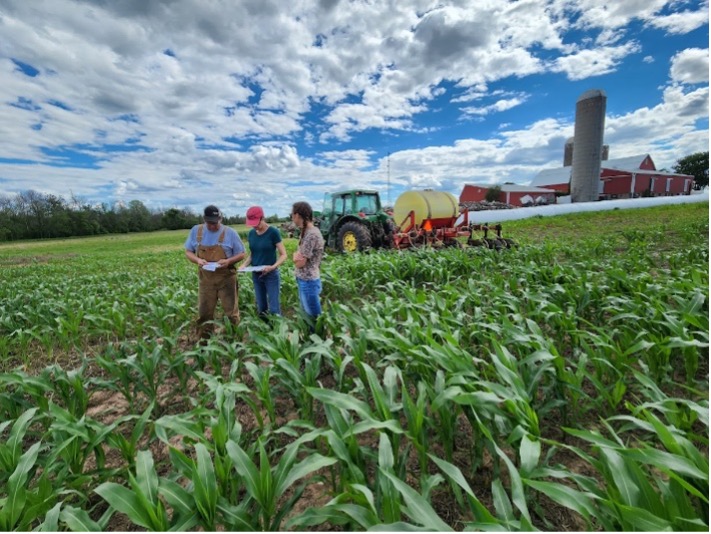
“An attendee at a past [watershed group] event asked us if we were seeing any decrease in yields with planting cover crops, and nobody could really answer that question. And there’s been a lot of talk that the cover crop ties up nitrogen and can hamper your yield, so we’re doing this study to find out if cover crops have a detrimental effect on your cash crop.
Because of this research, now we’ve had a few other farmers that would like to get involved in our group. So for next year, we’re looking at doing a Return on Investment (ROI) study with less sampling just to get some of the members looking at the numbers because we’ve got to make money at some point in time.”
— Jim Luedtke, farmer in Winnebago County and Muddy Bottom Farmers producer-led watershed group president
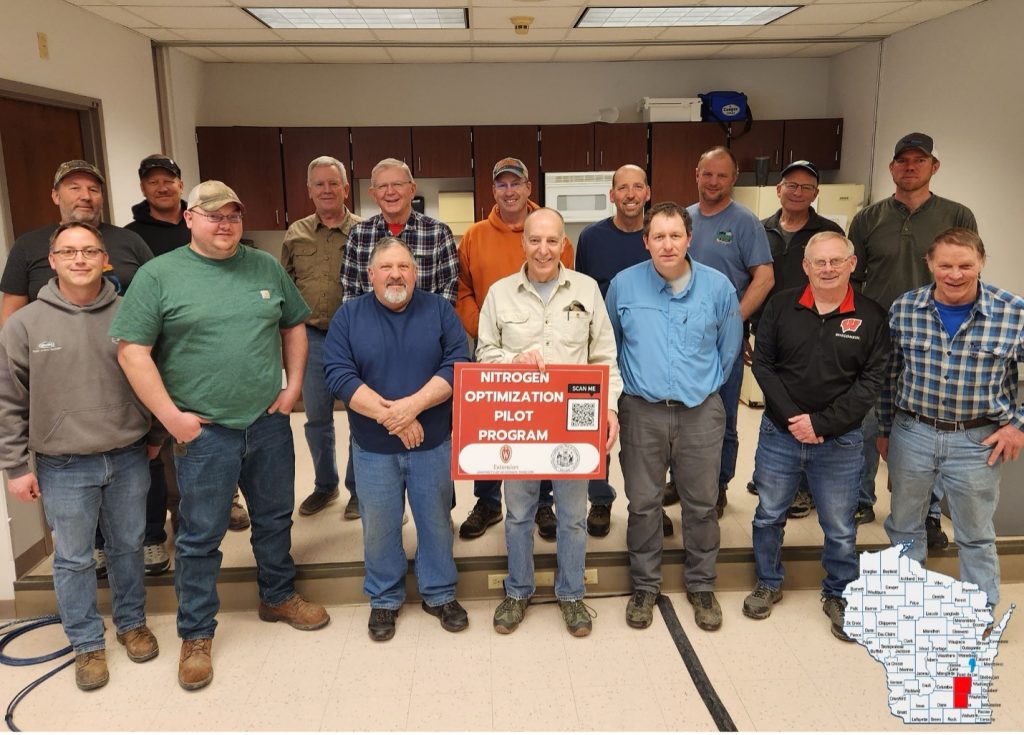
“Producers within Dodge County and the Upper Rock River Basin farm areas are dominated by dolomitic bedrock, which are prone to groundwater pollution. Reducing groundwater contamination is a major concern for Dodge County farmers and was one of the main reasons the [producer-led watershed] group was formed, as this area is already experiencing high levels of groundwater nitrates.
Our long term goal is to identify strategies that reduce losses of nitrogen to the environment and balance profitability for farmers while preserving groundwater quality. Instead of capturing specific practices, the strength of our project will provide a wide variety of management, tillage, rotation, and soils across a large geographic area and participating farmers over two (or more) years, using field-scale farm equipment and plots.”
— Dodge County Farmers for Healthy Soil and Healthy Water producer-led watershed group
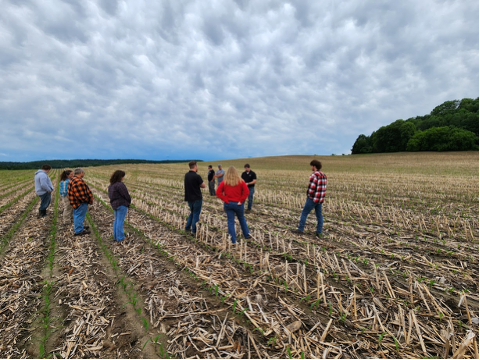
“We found that, through some of our watershed’s groundwater sampling, we’ve had some wells that came back high in nitrate. In general, we have found some of our sandier soils, primarily in this region closer to the Red Cedar [River] have been a little bit higher in nitrate, so if we can better optimize our nitrogen recommendations through the NOPP group, we might have some new interesting findings that we can share with the group and surrounding areas.
Working with UW and with the Red Cedar Conservation Farmers group has been good, and we’ve got a few different producers – Mike, myself, Jeco, and Bill. All of us have different fields that are conducting trials to increase nitrogen efficiency while considering the effect of other management practices such as cover crops, tillage, etc..”
— Tryston Beyrer, farmer in Dunn County and Red Cedar Conservation Farmers producer-led watershed group member
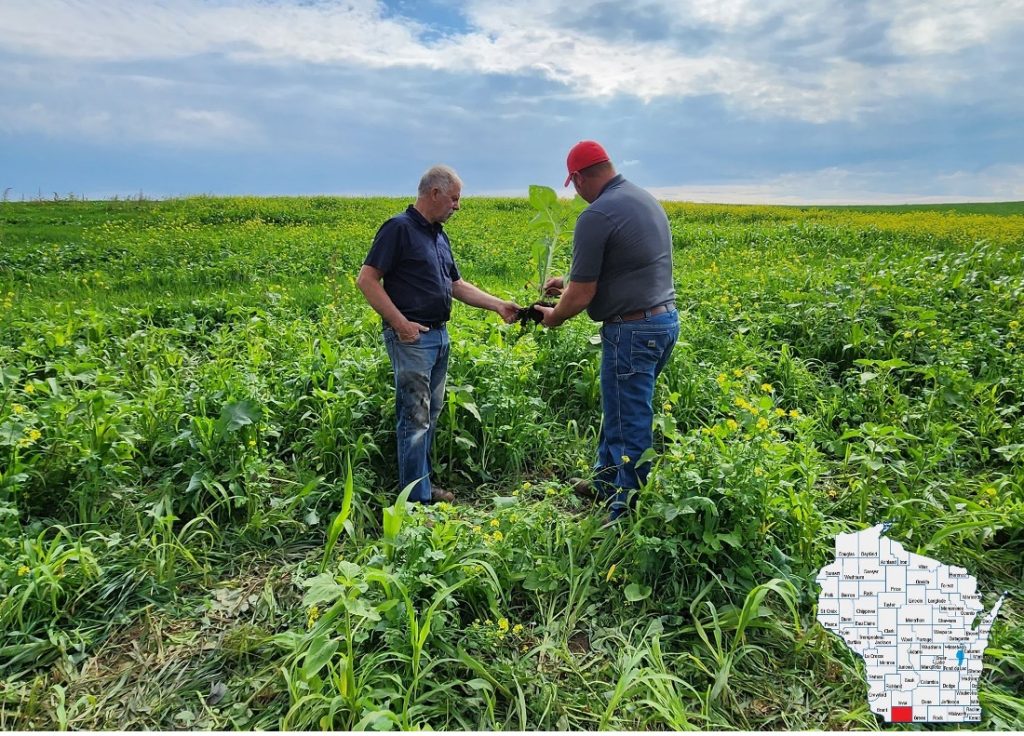
“A motivating factor for pursuing NOPP funding is the opportunity to conduct local on-farm, field-scale research within the driftless region of Wisconsin. Due to a high risk of soil and nutrient runoff and nutrient leaching in this geography, this project will evaluate the N management requirements necessary to increase acres of cover cropping and no-till across the region. In addition, the ability for producers to conduct field-scale research on-farm offers increased validity and acceptance amongst growers compared to remote, small-plot research.”
— Lafayette Ag Stewardship Alliance producer-led watershed group
“Our rich soil and water resources are among our state’s greatest assets. As stewards of the land, Wisconsin farmers understand the value of those natural resources and work hard day after day, year after year to ensure that our farmland is properly maintained for future generations. NOPP grants provide yet another opportunity for farmers across the state to actively preserve those soil and water resources, and to explore and better understand how their work impacts both.
By encouraging them to ask questions and seek answers through data-driven research, Wisconsin farmers are identifying new methods and opportunities in nitrogen optimization and are passing on their findings to others in the agricultural community. This helps to further improve those resources, strengthen the knowledge base for future generations, and inform the kinds of agricultural practices Wisconsin farmers will adopt and implement in the years to come.”
— Susan Mockert, Conservation Grants Supervisor, DATCP
A Closer Look at Manure Management in Corn Systems
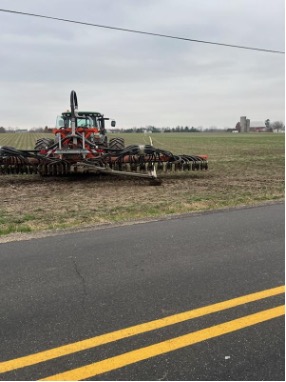
In 2024, seven farmers across Wisconsin united under a shared interest in investigating manure and nitrogen management on their own farms. While manure is a valuable nutrient source, nutrient availability is quite variable. Across Wisconsin farms, manure nitrogen varies by animal type and diet, storage and handling, application timing and method, and even that year’s soil and weather conditions.
These farmers were interested in understanding their farms’ unique manure and how manure applications may influence optimal synthetic nitrogen fertilizer rates for their specific soils, management systems, and local growing conditions.
To tackle this research question, NOPP grantees (spanning Burnett, Chippewa, Oconto, Kewaunee, Washington, and Rock counties) partnered with their local trusted agronomists and Extension educators to investigate how manure applications impact optimal nitrogen fertilizer rates in corn grain or corn silage. Trials at each site in 2024 were designed with six nitrogen rates, replicated four times both with and without manure.
These trials will not only inform manure and nitrogen management for participating farmers but also provide greater insight on manure nitrogen crediting that will inform state nitrogen recommendation guidelines.
Cereal Rye Cover Crops: How do we optimize our systems?
Like many farmers in Wisconsin, Jim Stute, farmer and agronomist in Walworth County, plants cover crops after the harvest of his cash crop to decrease soil erosion, improve water movement through the soil profile, and reduce nitrate leaching during the non-growing season.
While there are many conservation benefits of cover crops, one of the challenges he faces is how the cover crop may impact nitrogen availability for the following cash crop. To better understand how to manage his cover crops and nitrogen inputs for conservation benefits and economic return, Jim developed an NOPP trial to investigate the effect of a cereal rye cover crop, cover crop termination timing, and nitrogen rate on corn yield.
Jim’s project aims to answer two questions: “Do I need to adjust my nitrogen rate based on my cover crop management?” and “What impact does the cereal rye cover crop have on yield?”
In 2024, his trial was set up with six nitrogen rates (including 0N) and three cereal rye cover crop treatments: no cover crop, early-terminated, and late-terminated cover crops. His project will continue into 2025 to provide data from two different growing seasons towards answering his research question.
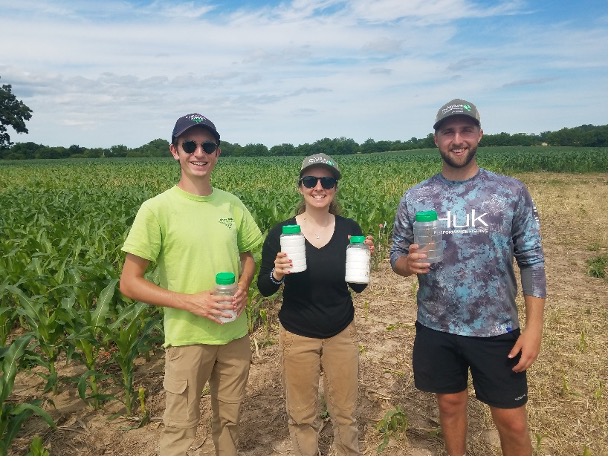
Jim Stute experienced extremely wet years at his farm in East Troy, and the excess moisture was impacting planting dates and crop rotations. To manage the excess moisture, he planted a cereal rye cover crop on all his acres in 2020, “but then there’s this nagging question: ‘How do we adjust our nitrogen management?’” for the cover cropped corn system.
An agronomist and farmer, Jim has plenty of experience with on-farm research and has learned over the years “You may start, but the farm’s a busy place in fall and you may forego the harvest of those trial plots because you got to get something [else] done.” Therefore, Jim plugs NOPP as a motivating factor to complete the project: “If you’re compensated for doing it, you pay attention to it, and you also complete the task because suddenly it’s much more important in your order of operations.”
Understanding Water Quality Impacts by Leveraging Partners at the Universities of Wisconsin
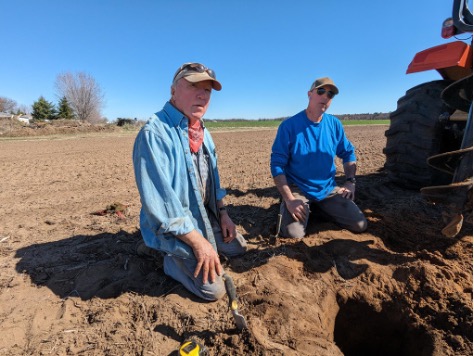
Farmer Isaac Isherwood “hopes to get the same yield and quality with fewer nitrogen inputs.”
Taking it a step further, he explains that it’s “okay spending more on biological products when you can reduce environmental pollution of nitrogen,” and that “it makes you feel good feeding people with the most healthy and sustainable product as possible.”
— Isaac Isherwood, farmer in
Portage County
Nitrogen fertilizer that is unused by the crop remains in the soil and is susceptible to losses, posing a risk to environmental and human health. Monitoring equipment used to estimate nitrogen leaching is often expensive and labor-intensive. In addition, field-scale monitoring does not help us understand the impacts of individual nitrogen rate treatments across the field.
Resin lysimeters are cost-effective and hands-off (once installed) devices that can provide insights into the leaching potential of individual plot treatments in a nitrogen rate trial. Dr. Steven Hall, UW–Madison Department of Plant and Agroecosystem Sciences, provided materials, expertise, and analysis for resin lysimeters installed in two NOPP-funded projects in 2024. While the utilization of resin lysimeters in nitrogen rate trials won’t provide a total amount of leachable nitrate within each plot, they will allow for comparison between treatments. One of the two NOPP projects utilizing resin lysimeters is a potato nitrogen rate trial in Portage County at Isherwood Family Farms.
Potatoes pose a higher risk of nitrate leaching due to their relatively high nitrogen requirement and the sandy soil they’re grown in. For this reason, Portage County potato grower Isaac Isherwood partnered with Extension Agriculture Water Quality Outreach Specialist Guolong Liang to implement an on-farm nitrogen rate trial with resin lysimeters installed in each plot. The lysimeters were installed before potato planting and will collect leaching data for an entire year before being removed and the findings analyzed. Additionally, Isaac Isherwood has included an experimental treatment of products including humic acid and fulvic acid to further investigate the prospect of reducing risks of nitrate leaching.
Collaboration among DATCP; UW; and participating producers, agronomists, and partners is key to NOPP’s success. DATCP administers the Nitrogen Optimization Pilot Project and supports NOPP grantees with grant application, administration, reimbursement, and reporting processes.
UW provides technical support, data analysis, and outreach for NOPP programming. UW supports grant recipients with trial design, implementation, data analysis, and interpretation to achieve high-quality on-farm research trials that address producers’ questions and contribute to UW’s statewide nitrogen rate recommendations. In addition, UW develops outreach programming to share NOPP goals, findings, and insights into nitrogen best management practices to participants and Wisconsin’s wider agricultural community.
Participating producers, agronomists, conservationists, and other partners develop their own research questions, implement the trials, collect and report data throughout the season, and share their findings with their communities.
NOPP Projects Awarded, 2023-2024
| Applicant and Funding Year | Crop(s) | Treatment(s) | Number of Farmers Involved | Trials to Date | Partners |
|---|---|---|---|---|---|
| Alits, 2023 | Corn grain | N-rate | 2 | 5 | Independent agronomist |
| Albright, 2023 | Corn grain | N-rate + Augmenta Camera System | 1 | 2 | Extension |
| Blank, 2023 | Winter triticale | N-rate | 3 | 3 | Agronomist |
| Bragger, 2023 | Corn grain | N-rate + Poultry Litter | 2 | 2 | Agronomist, Extension |
| Cran Creek, 2023 | Cranberry | N-rate + Timing | 1 | 2 | Extension, UW Faculty |
| Dodge, 2023 | Corn grain | N-rate | 13 | 24 | Independent agronomist, producer-led group |
| Hebbe, 2023 | Corn grain | N-rate + Biological N Product | 1 | 2 | Extension |
| InDepth, 2023 | Corn grain | N-rate | 2 | 4 | Independent agronomist |
| LASA, 2023 | Corn grain | N-rate + Rye Cover Crop | 3 | 3 | Extension, non-profit, producer-led group |
| McCain, 2023 | Potato | N-rate + Timing | 2 | 2 | Agronomist |
| MFAI, 2024-25 | Corn grain | N-rate + Multi-species Cover Crop | 3 | 3 | Extension, non-profit |
| Novak, 2023 | Corn grain | N-rate + Soil Types | 1 | 2 | Independent agronomist |
| Novak, 2023 | Corn grain | N-rate + Biological N Product | 1 | 2 | Independent agronomist |
| Powell-Smith, 2023 | Forage mix | N-rate | 2 | 4 | Independent agronomist |
| RCCF, 2023 | Corn grain | N-rate + Cover Crop Termination Timing | 3 | 4 | County land conservation, producer-led group |
| RCCF, 2023 | Corn grain | N-rate + Manure Incorporation | 1 | 2 | County land conservation, producer-led group |
| Towne/Paris, 2023 | Corn grain | N-rate + Winter Bale Grazing | 2 | 1 | Agronomist, Extension |
| Turzinski, 2023 | Corn grain | N-rate + Biological N Product + Rye Cover Crop | 1 | 2 | Extension |
| Weichmann, 2023-24 | Corn grain | N-rate + Cover Crop Mixes | 1 | 2 | Independent agronomist |
| WWCC, 2023 | Corn grain | N-rate | 2 | 4 | Independent agronomist, UW Faculty |
| Albright Bros, 2024 | Corn grain | N-rate + Manure Rates | 1 | 1 | County land conservation, Extension |
| Bell, 2024 | Corn grain | N-rate + Interseeded Clover Cover Crop | 1 | 1 | Agronomist |
| Bibby, 2024 | Sunflower | N-rate | 1 | 1 | Extension |
| Bonin, 2024 | Corn grain | N-rate + Biological N Product | 1 | 1 | Agronomist |
| Chippewa Valley, 2024 | Corn grain or corn silage | N-rate + Manure | 7 | 7 | Agronomist, Extension, UW Faculty |
| Coloma, 2024 | Potato | N-rate + Glycical Application | 1 | 1 | Agronomist, UW Faculty |
| Golden E Dairy, 2024 | Corn grain | N-rate | 1 | 1 | Independent agronomist |
| Insight, 2024 | Corn grain | N-rate + Variable Rate N | 1 | 1 | Independent agronomist |
| Isherwood, 2024 | Potato | N-rate | 1 | 1 | Extension, UW Faculty |
| Kleiber, 2024 | Corn grain | N-rate + Sulfur | 1 | 1 | County land conservation, independent agronomist |
| Lien, 2024 | Corn grain | N-rate + Hog Manure | 1 | 1 | Extension |
| MBF, 2024 | Corn grain | N-rate + Cover Crop | 3 | 3 | County land conservation, producer-led group |
| McCain, 2024 | Potato | N-rate + Timing | 2 | 3 | Agronomist |
| Salzwedel, 2024 | Cranberry | N App Frequency | 1 | 1 | Extension, UW Faculty |
| Stute, 2024 | Corn grain | N-rate + Rye Cover Crop Termination Timing | 1 | 1 | Independent agronomist, non-profit |
| Vilas, 2024 | Cranberry | N-rate + Timing | 1 | 1 | Extension, UW Faculty |
| Weichmann, 2024 | Corn grain | N-rate + Alfalfa Cover Crop Termination Timing | 1 | 1 | Extension, independent agronomist |
Download PDF Report
Learn more about the Nitrogen Optimization Pilot Program
Find outreach events, NOPP news, and project spotlights.

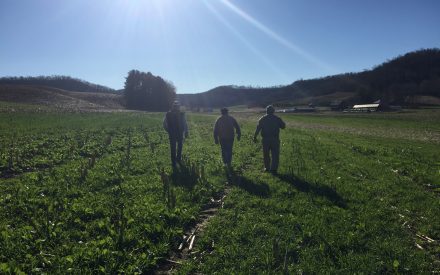 ▶ Nitrogen Optimization Pilot Program 2025 Updates
▶ Nitrogen Optimization Pilot Program 2025 Updates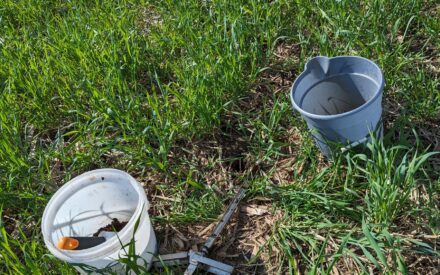 ▶ Evaluating MRTN Rates for Corn Grain and Silage After Manure Application
▶ Evaluating MRTN Rates for Corn Grain and Silage After Manure Application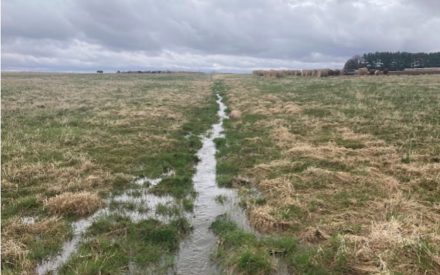 ▶ How Does Nitrate Leaching Respond to Nitrogen Inputs from Fertilizer and Manure?
▶ How Does Nitrate Leaching Respond to Nitrogen Inputs from Fertilizer and Manure? ▶ Nitrogen Optimization Pilot Program 2024 Annual Report Highlights
▶ Nitrogen Optimization Pilot Program 2024 Annual Report Highlights


